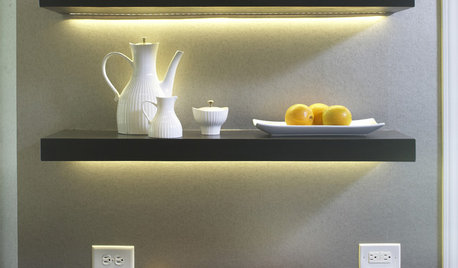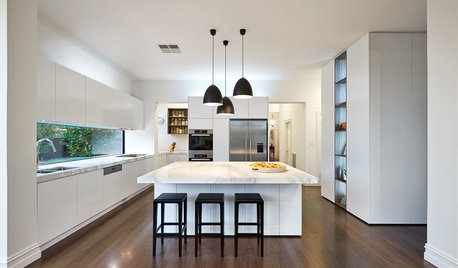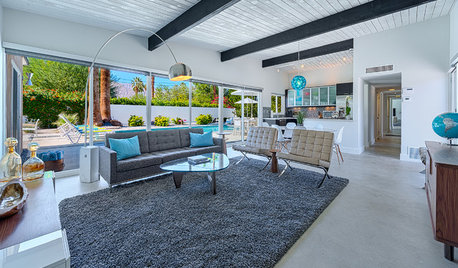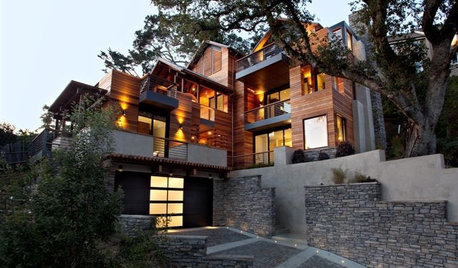Fluorescent vs LED
parker25mv
8 years ago
last modified: 8 years ago
Featured Answer
Sort by:Oldest
Comments (38)
aruzinsky
8 years agoscorpio_bafh
8 years agolast modified: 8 years agoRelated Discussions
CA Title 24 - Juno vs. Halo
Comments (3)Avoid the fluorescent cans. I know. I repeat this- a lot. But it's worth it. The Cree LR4 is a 5" LED. It's a very slick looking fixture. You can also go with the LR6 (which is less expensive and a 6"). But you'll save much more energy going the LED route. You won't have ballast issues. You'll be able to dim the bulbs and the overall light color is so far superior to fluorescent. And not in the least- there's no poisonous Mercury in the LED bulb... which, by the way, will last about 30 years in your kitchen. Just the fact that you have to ask those questions about fluorescent bulbs and that you don't need to for LED should give a good idea to the inferiority of fluorescent vs LED....See MoreFluorescent vs Recessed LED - Is my math wrong?
Comments (3)Fluorescents are currently the king of the lowest initial cost, high output, long running time category. Like wws944 said, the typical fixture/ enclosure used could dramatically cut the actual usable output. I was initially loath to give up my recessed fluorescent light box, but the benefits of having a higher ceiling forced the decision. In the end, the Lr6 downlights worked out far better than the original....See MoreGeneral and lighting plan feedback requested
Comments (2)buehl - oops, I can see why you'd ask. Sorry. Yes, it WILL matter what you have to say! I think my frustration was showing; I keep thinking I'm done with the plan, and then something else comes up and a change needs to happen. But I really would love feedback now, before I actually do go apply for a permit. Thanks for the pointer to the Lighting Forum, it's great to know there's another place to ask specifically about lighting....See Morexenon vs. LED vs. fluorescent undercab lighting
Comments (27)Yes; they are the fixtures; what they list on their undercabinet LED page as light arrays. We have two runs; we were able to do the wiring as part of the remodel while we were down to the sheetrock. If you look at the specs for the lighting, you will see that there is a 6' power supply cord. One end plugs into one end of the light array. That cable then goes into the wall and comes out behind a base cabinet. The lights are wired to a switch; wiring from the switch comes out at the same point as the power supply cord. The two are brought through a hole in the back of a base cabinet. The wire to the switch is spliced to the power cord of the transformer (after cutting off the plug). The power supply cord plugs into the transformer. The transformer sits in the cabinet. For one run, we have the transformer at the bottom of the cabinet behind and under a drawer; the other happened to line up with the cabinet that holds our trash pullout. That had a little shelf between the bins and the top drawer; the transformer sits on the shelf. Here is a little drawing; hopefully it will make this clearer:...See Morearuzinsky
8 years agolast modified: 8 years agoscorpio_bafh
8 years agoaruzinsky
8 years agolast modified: 8 years agoscorpio_bafh
8 years agolast modified: 8 years agoaruzinsky
8 years agoAlexander Magarovsky
8 years agolast modified: 8 years agogosssamer
8 years agoaruzinsky
8 years agogosssamer
8 years agoscorpio_bafh
8 years agolast modified: 8 years agoStu Zone 7a NY
8 years agogosssamer
8 years agoStu Zone 7a NY
8 years agoAlexander Magarovsky
8 years agoreeljake
8 years agoaruzinsky
8 years agofred o connor
8 years agoscorpio_bafh
8 years agoaruzinsky
8 years agoaruzinsky
8 years agolast modified: 8 years agofred o connor
8 years agoaruzinsky
8 years agofred o connor
8 years agopip313
8 years agoaruzinsky
8 years agoewwmayo
8 years agoaruzinsky
8 years agolast modified: 8 years agoAlexander Magarovsky
8 years agofred o connor
8 years agoewwmayo
8 years agoaruzinsky
8 years agofred o connor
8 years agoMonyet
8 years agoaruzinsky
8 years agoMonyet
8 years ago
Related Stories

LIGHTINGWhat to Know About Switching to LED Lightbulbs
If you’ve been thinking about changing over to LEDs but aren't sure how to do it and which to buy, this story is for you
Full Story
LIGHTINGThe Lowdown on High-Efficiency LED Lighting
Learn about LED tapes, ropes, pucks and more to create a flexible and energy-efficient lighting design that looks great
Full Story
KITCHEN DESIGN12 Ways to Light Your Kitchen With LEDs
See how to use new energy-saving lights to illuminate your kitchen, light a countertop and add style, too
Full Story
LIGHTING8 Creative Lighting Solutions for Food Prep
Get all the task illumination you need while distracting the eye from fluorescents, following the lead of the kitchens here
Full Story
FUN HOUZZ10 Things People Really Don’t Want in Their Homes
No love lost over fluorescent lights? No shocker there. But some of these other hated items may surprise you
Full Story
LIGHTINGBask in Lamplight's Comfort This Season
Get pro insight on lamp styles, shades and ever-confusing bulbs to enjoy the benefits of lamplight on long, cold nights
Full Story
BATHROOM DESIGN4 Secrets to a Luxurious Bathroom Look
Give your bathroom a finished feel with a few splurges and budget-stretching moves
Full Story
LIGHTING8 Ways to Get Ambient Lighting Just Right
See clearly, boost energy and create the mood you want with these tips for harnessing natural and artificial light
Full Story
KITCHEN DESIGN3 Steps to Choosing Kitchen Finishes Wisely
Lost your way in the field of options for countertop and cabinet finishes? This advice will put your kitchen renovation back on track
Full Story




aruzinsky